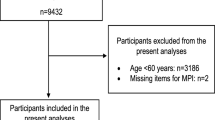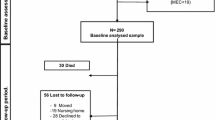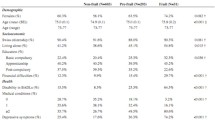Abstract
Frailty is a dynamic clinical syndrome considered as part of an age-associated continuum of severity, including pre-frailty as an intermediate frailty status with potential reversibility to robustness. The main purpose of this study was to analyse the relationship between the different domains of quality of life, functional dependence and depressive symptomatology in older adults diagnosed as pre-frail, before progression to frailty occurs. Logistic regression analyses were conducted to examine whether sex, age, level of education and scores in the Geriatric Depression Scale 15-item Short Form (GDS-SF) and the Instrumental Activities of Daily Living Lawton scale determine the worst score in the WHOQOL-BREF (World Health Organization Quality of Life) in older adults meeting one or two frailty phenotypic criteria. Depressive symptomatology (GDS-SF score) was the main determinant of poor quality of life in both groups, and in all areas of WHOQOL-BREF. Age was only associated with poor satisfaction with own health. Female sex and low educational level were linked to low physical QOL and poor self-rated health, respectively, but only in older adults meeting one frailty criterion. Association between functional status and WHOQOL-BREF scores was only found in the univariate analysis. These results underline the importance of identifying multiple aspects, but mainly the presence of depressive symptomatology, as risk factors for all dimensions of quality of life in the pre-frailty process, where interventions might be targeted to reduce the progression of pre-frailty and frailty in older adults.
Similar content being viewed by others
References
Aghamolaei, T., Tavafian, S. S., & Zare, S. (2010). Health related quality of life in elderly people living in Bandar Abbas, Iran: a population-based study. Acta Medica Iranica, 48(3), 185–191.
Almeida, O. P., & Almeida, S. A. (1999). Short versions of the geriatric depression scale: a study of their validity for the diagnosis of a major depressive episode according to ICD-10 and DSM-IV. International Journal of Geriatric Psychiatry, 14, 858–865.
Azpiazu Garrido, M., Cruz Jentoft, A., Villagrasa Ferrer, J. R., Abanades Herranz, J. C., García Marín, N., & Álvarez de Mon Rego, C. (2003). Quality of life in non-institutionalized persons older than 65 years in two health care districts in Madrid. Atención Primaria, 31(5), 285–294.
Bandeen-Roche, K., Seplaki, C. L., Huang, J., Buta, B., Kalyani, R. R., Varadhan, R., et al. (2015). Frailty in older adults: a nationally representative profile in the United States. Journals of Gerontology Series A- Biological Sciences and Medical Sciences, 70(11), 1427–1434.
Beekman, A. T. F., Copeland, J. R. M., & Prince, M. J. (1999). Review of community prevalence of depression in later life. The British Journal of Psychiatry, 174, 307–311.
Bilotta, C., Bowling, A., Casè, A., Nicolini, P., Mauri, S., Castelli, M., et al. (2010). Dimensions and correlates of quality of life according to frailty status: a cross-sectional study on community dwelling older adults referred to an outpatient geriatric service in Italy. Health and Quality of Life Outcomes, 8, 56.
Bilotta, C., Bowling, A., Nicolini, P., Casè, A., Pina, G., Rossi, S. V., et al. (2011). Older People’s Quality of Life (OPQOL) scores and adverse health outcomes at a one-year follow-up. A prospective cohort study on older outpatients living in the community in Italy. Health and Quality of Life Outcomes, 9, 72.
Buttery, A. K., Busch, M. A., Gaertner, B., Scheidt-Nave, C., & Fuchs, J. (2015). Prevalence and correlates of frailty among older adults: findings from the German health interview and examination survey. BMC Geriatrics, 15, 22.
Calsyn, R. J., & Winter, J. P. (1999). Who attends senior centers? Journal of Social Services Research, 26, 53–69.
Camicioli, R., Mizrahi, S., Spagnoli, J., Büla, C., Demonet, J. F., Vingerhoets, F., et al. (2015). Handwriting and pre-frailty in the Lausanne cohort 65+ (Lc65+) study. Archives of Gerontology and Geriatrics, 61, 8–13.
Chachamovich, E., Fleck, M., Laidlaw, K., & Power, M. (2008). Impact of major depression and subsyndromal symptoms on quality of life and attitudes toward aging in an international sample of older adults. The Gerontologist, 48(5), 593–602.
Chang, Y. W., Chen, W. L., Lin, F. G., Fang, W. H., Yen, M. Y., Hsieh, C. C., et al. (2012). Frailty and its impact on health-related quality of life: a cross-sectional study on elder community-dwelling preventive health service users. PloS One, 7(5), e38079.
Chang, Y. E., Yao, G., Hu, S. C., & Wang, J. D. (2015). Depression affects the scores of all facets of the WHOQOL-BREF and may mediate the effects of physical disability among community-dwelling older adults. PloS One, 10(5), e0128356.
Chen, C. Y., Wu, S. C., Cheng, L. J., & Lue, B. H. (2010). The prevalence of subjective frailty and factors associated with frailty in Taiwan. Archives of Gerontology and Geriatrics, 50(Suppl.1), S43–S47.
Cohen, J. (1988). Statistical power analysis for the behavioural sciences (2nd ed.). Hillsdale: Erlbaum.
Collard, R. M., Boter, H., Shoevers, R. A., & Voshaar, R. C. (2012). Prevalence of frailty in community-dwelling older persons: a systematic review. Journal of the American Geriatrics Society, 60, 1487–1492.
de Almeida Moreira, P., Carneiro Roriz, A. K., Mello, A. L., & Ramos, L. B. (2016). Quality of life of institutionalized elderly in Brazil. Social Indicators Research, 126, 187–197.
Drey, M., Wehr, H., Wehr, G., Uter, W., Lang, F., Rupprecht, R., et al. (2011). The frailty syndrome in general practitioner care. Zeitschrift für Gerontologie und Geriatrie, 44, 48–54.
Fernández-Garrido, J., Ruiz-Ros, V., Buigues, C., Navarro-Martinez, R., & Cauli, O. (2014). Clinical features of prefrail older individuals and emerging peripheral biomarkers: a systematic review. Archives of Gerontology and Geriatrics, 59, 7–17.
Ferrer, A., Formiga, F., Almeda, J., Alonso, J., Brotons, C., & Pujol, R. (2010). Calidad de Vida en nonagenarios: género, funcionalidad y riesgo nutricional Como factores asociados [Health-related quality of life in nonagenarians: gender, functional status and nutritional risk as associated factors]. Medicina Clínica, 134(7), 303–306.
Fillit, H., & Butler, R. N. (2009). The frailty identity crisis. Journal of the American Geriatrics Society, 57, 348–352.
Fried, L. P., Tangen, C. M., Walston, J., Newman, A. B., Hirsch, C., Gottdiener, J., et al. (2001). Frailty in older adults: evidence for a phenotype. Journals of Gerontology Series A- Biological Sciences and Medical Sciences, 56A(3), M146–M156.
Fried, L. P., Ferrucci, L., Darer, J., Williamson, J. D., & Anderson, G. (2004). Untangling the concepts of disability, frailty, and comorbidity: implications for improved targeting and care. Journals of Gerontology Series A- Biological Sciences and Medical Sciences, 59(3), 255–263.
Giebel, C. M., Sutcliffe, C., & Challis, D. (2015). Activities of daily living and quality of life across different stages of dementia: a UK study. Aging & Mental Health, 19(1), 63–71.
Gobbens, R. J. J., & van Assen, M. A. L. M. (2014). The prediction of quality of life by physical, psychological and social criteria of frailty in community-dwelling older people. Quality of Life Research, 23, 2289–2300.
Gobbens, R. J. J., van Assen, M. A. L. M., Luijkx, K. G., Wijnen-Sponselee, M. T., & Schols, J. M. G. A. (2010). The Tilburg Frailty Indicator: Psychometric Properties. Journal of the American Medical Directors Association, 11, 344–355.
Gobbens, R. J. J., Luijkx, K. G., & Van Assen, M. A. L. M. (2013). Explaining quality of life of older people in the Netherlands using a multidimensional assessment of frailty. Quality of Life Research, 22, 2051–2061.
Hirve, S., Oud, J. H. L., Sambhudas, S., Juvekar, S., Blomstedt, Y., Tollman, S., et al. (2014). Unpacking self-rated health and quality of life in older adults and elderly in India: a structural equation modelling approach. Social Indicators Research, 117, 105–119.
Hogan, D. B., MacKnight, C., Bergman, H., on behalf of the Steering Committee, & Canadian Initiative on Frailty and Aging. (2003). Models, definitions, and criteria of frailty. Aging Clinical and Experimental Research, 15(Suppl 3), 3–29.
Hsieh, C. M. (2009). Health, quality of care and quality of life: a case of frail older adults. Social Indicators Research, 94, 61–73.
Instituto Nacional de Estadística. (2011). Encuesta Nacional de Salud [National Health Survey]. Madrid: Instituto Nacional de Estadística.
Kulminski, A. M., Ukraintseva, S. V., Kulminskaya, I. V., Arbeev, K. G., Land, K., & Yashin, A. I. (2008). Cumulative deficits better characterize susceptibility to death in elderly people than phenotypic frailty: lessons from the Cardiovascular Health Study. Journal of the American Geriatrics Society, 56, 898–903.
Lawton, M. P., & Brody, E. M. (1969). Assessment of older people: self-maintaining and instrumental activities of daily living. The Gerontologist, 9(3), 179–186.
Levers, M. J., Estabrooks, C. A., & Ross Kerr, J. C. (2006). Factors contributing to frailty: literature review. Journal of Advanced Nursing, 56(3), 282–291.
Lewis, E. F., Lamas, G. A., O’Meara, E., Granger, C. B., Dunlap, M. E., McKelvie, R. S., et al. (2007). Characterization of health-related quality of life in heart failure patients with preserved versus low ejection fraction in CHARM. European Journal of Heart Failure, 9, 83–91.
Lin, C. C., Li, C. I., Chang, C. K., Liu, C. S., Lin, C. H., Meng, N. H., et al. (2011). Reduced health-related quality of life in elders with frailty: a cross-sectional study of community-dwelling elders in Taiwan. PloS One, 6(7), e21841.
Lohman, M. C., Mezuk, B., & Dumenci, L. (2015). Depression and frailty: concurrent risks for adverse health outcomes. Aging & Mental Health. doi:10.1080/13607863.2015.1102199.
Lorenzo-López, L., López-López, R., Maseda, A., Diego-Díez, C., Gómez Caamaño, S., & Millán-Calenti, J. C. (2016). Prevalence and clinical characteristics of prefrailty in elderly adults: differences according to degree of urbanization. Journal of the American Geriatrics Society, 64(1), 221–223.
Lucas-Carrasco, R. (1998). Versión española del WHOQOL [Spanish version of WHOQOL]. Madrid: Ergón.
Martínez de la Iglesia, J., Onís Vilches, M. C., Dueñas Herrero, R., Albert Colomer, C., Aguado Taberné, C., & Luque-Luque, R. (2002). Versión española del cuestionario de Yesavage abreviado (GDS-SF) para el despistaje de depresión en mayores de 65 años: adaptación y validación. [The Spanish version of the Yesavage abbreviated questionnaire (GDS) to screen depressive dysfunctions in patients older than 65 years]. MEDIFAM: Revista de Medicina Familiar y Comunitaria, 12, 620–630.
Maseda, A., Gómez-Caamaño, S., Lorenzo-López, L., López-López, R., Diego-Diez, C., Sanluís-Martínez, V., et al. (2016). Health determinants of nutritional status in community-dwelling older population: the VERISAÚDE study. Public Health Nutrition, 19(12), 2220–2228.
Masel, M. C., Graham, J. E., Reistetter, T. A., Markides, K. S., & Ottenbacher, K. J. (2009). Frailty and health related quality of life in older Mexican Americans. Health and Quality of Life Outcomes, 7, 70.
Millán-Calenti, J. C., Tubío, J., Pita-Fernández, S., González-Abraldes, I., Lorenzo, T., Fernández-Arruty, T., et al. (2010). Prevalence of functional disability in activities of daily living (ADL), instrumental activities of daily living (IADL) and associated factors, as predictors of morbidity and mortality. Archives of Gerontology and Geriatrics, 50, 306–310.
Miner, S., Logan, J. R., & Spitze, G. (1993). Predicting the frequency of senior center attendance. The Gerontologist, 33, 650–657.
Morley, J. E., Vellas, B., Abellan van Kan, G., Anker, S. D., Bauer, J. M., Bernabei, R., et al. (2013). Frailty consensus: a call to action. Journal of the American Medical Directors Association, 14(6), 392–397.
Nascimiento, P. P. P., Batistoni, S. S. T., & Neri, A. L. (2016). Frailty and depressive symptoms in older adults: data from the FIBRA study–UNICAMP. Psicologia: Reflexão e Crítica, 29, 16.
Nourhashémi, F., Andrieu, S., Gillette-Guyonnet, S., Vellas, B., Albarède, J. L., & Grandjean, H. (2001). Instrumental activities of daily living as a potential marker of frailty: a study of 7364 community-dwelling elderly women (the EPIDOS study). Journals of Gerontology Series A- Biological Sciences and Medical Sciences, 56A(7), M448–M453.
Ormel, J., Rijsdijk, F. V., Sullivan, M., van Sonderen, E., & Kempen, G. I. J. M. (2002). Temporal and reciprocal relationship between IADL/ADL disability and depressive symptoms in late life. Journals of Gerontology Series B- Psychological Sciences and Social Sciences, 57B(4), P338–P347.
Palgi, Y., Shrira, A., & Zaslavsky, O. (2015). Quality of life attenuates age-related decline in functional status of older adults. Quality of Life Research, 24, 1835–1843.
Ponte, C., Almeida, V., & Fernandes, L. (2014). Suicidal ideation, depression and quality of life in the elderly: study in a gerontopsychiatric consultation. Spanish Journal of Psychology, 17, e14.
Radloff, L. S. (1977). The CES-D scale: a self-report depression scale for research in the general population. Applied Psychological Measurement, 1, 385–401.
Reis, W. M., Carneiro, J. A. O., Coqueiro, R. D., Santos, K. T., & Fernandes, M. H. (2014). Pre-frailty and frailty of elderly residents in a municipality with a low human development index. Revista Latino-Americana de Enfermagem, 22(4), 654–661.
Renaud, J., & Bédard, E. (2013). Depression in the elderly with visual impairment and its association with quality of life. Clinical Interventions in Aging, 8, 931–943.
Rockwood, K., Stadnyk, K., MacKnight, C., McDowell, I., Hébert, R., & Hogan, D. B. (1999). A brief clinical instrument to classify frailty in elderly people. The Lancet, 353, 205–206.
Ruiz Comellas, A., Pera, G., Baena Díez, J. M., Mundet Tuduri, X., Alzamora Sas, T., Elosua, R., et al. (2012). Validación de una versión reducida en español del cuestionario de actividad física en el tiempo libre de Minnesota (VREM) [Validation of a Spanish Short Version of the Minnesota Leisure Time Physical Activity Questionnaire (VREM)]. Revista Española de Salud Pública, 86, 495–508.
Ruiz-Grosso, P., Loret de Mola, C., Vega-Dienstmaier, J. M., Arevalo, J. M., Chavez, K., Vilela, A., et al. (2012). Validation of the Spanish Center for Epidemiological Studies Depression and Zung Self-Rating Depression Scales: a comparative validation study. PloS One, 7, e45413.
Sheikh, J. I., & Yesavage, J. A. (1986). Geriatric Depression Scale (GDS-SF). Recent evidence and development of a shorter version. Clinical Gerontologist, 5(1/2), 165–173.
Shrira, A., & Litwin, H. (2014). The effect of lifetime cumulative adversity and depressive symptoms on functional status. Journals of Gerontology Series B- Psychological Sciences and Social Sciences, 69(6), 953–965.
Snih, S. A., Graham, J. E., Ray, L. A., Samper-Ternent, R., Markies, K. S., & Ottenbacher, K. J. (2009). Frailty and incidence of activities of daily living disability among older Mexican Americans. Journal of Rehabilitation Medicine, 41, 892–897.
Swinscow, T. D. V. (1997). Correlation and regression. Statistics at square one (9th ed.). University of Southampton: BMJ Publishing Group http://www.bmj.com/about-bmj/resources-readers/publications/statistics-square-one/11-correlation-and-regression. Accessed 30 April 2016.
Trentini, C. M., Chachamovich, E., Wagner, G. P., Müller, D. H., Hirakata, V. N., & Fleck, M. P. (2011). Quality of life (QOL) in a Brazilian sample of older adults: the role of sociodemographic variables and depression symptoms. Applied Research in Quality of Life, 6, 291–309.
Vandenbroucke, J. P., von Elm, E., Altman, D. G., Gøtzsche, P. C., Mulrow, C. D., Pocock, S. J., et al. (2014). Strengthening the Reporting of Observational Studies in Epidemiology (STROBE): explanation and elaboration. International Journal of Surgery, 12, 1500–1524.
Vaughan, L., Corbin, A. L., & Goveas, J. S. (2015). Depression and frailty in later life: a systematic review. Clinical Interventions in Aging, 10, 1947–1958.
Vergara, I., Bilbao, A., Orive, M., García Gutiérrez, S., Navarro, G., & Quintana, J. (2012). Validation of the Spanish version of the Lawton IADL Scale for its application in elderly people. Health Quality of Life Outcomes, 10(1), 130.
von Elm, E., Altman, D. G., Egger, M., Pocock, S. J., Gøtzsche, P. C., Vandenbroucke, J. P., et al. (2014). The Strengthening the Reporting of Observational Studies in Epidemiology (STROBE) statement: guidelines for reporting observational studies. International Journal of Surgery, 12, 1495–1499.
Wall, J. R., Lichtenberg, P. A., MacNeill, S. E., Walsh, P., & Deshpande, S. A. (1999). Depression detection in geriatric rehabilitation: geriatric depression scale short form vs. long form. Clinical Gerontologist, 20(3), 13–21.
WHOQOL Group. (1995). The World Health Organization Quality of Life assessment (WHOQOL): position paper from the World Health Organization. Social Science & Medicine, 41(10), 1403–1409.
WHOQOL Group. (1998). Development of the World Health Organization WHOQOL-BREF quality of life assessment. Psychological Medicine, 28(3), 551–558.
Wong, C. H., Weiss, D., Sourial, N., Karunananthan, S., Quail, J. M., Wolfson, C., et al. (2010). Frailty and its association with disability and comorbidity in a community-dwelling sample of seniors in Montreal: a cross-sectional study. Aging Clinical and Experimental Research, 22(1), 54–62.
Zaninotto, P., Falaschetti, E., & Sacker, A. (2009). Age trajectories of quality of life among older adults: results from the English Longitudinal Study of Ageing. Quality of Life Research, 18, 1301–1309.
Acknowledgements
The authors sincerely thank the staff and elderly users of the 43 senior centres who contributed to this study.
Author information
Authors and Affiliations
Corresponding author
Ethics declarations
The study protocol was drafted according to the principles embodied in the Declaration of Helsinki and was approved by the Ethics Committee of the University of A Coruña. Informed consent was obtained from all individual participants included in the study.
Conflict of Interest
The authors declare that they have no conflict of interest.
Funding
This research was supported by the Xunta de Galicia, project EM 2012/100: ‘VERISAUDE project: Effectiveness of the Comprehensive Gerontological Assessment (CGA) and longitudinal follow-up in the healthy ageing promotion’ and FrailNet network IN607C, 2016/08. The authors thank the World Health Organization for granting permission to use and providing the Spanish version of the WHOQOL-BREF.
Additional information
Ana Maseda and Laura Lorenzo-López contributed equally to this work.
Rights and permissions
About this article
Cite this article
Maseda, A., Lorenzo-López, L., Lorenzo, T. et al. Determinants of Quality of Life in Pre-Frail Older Adults According to Phenotypic Criteria: the VERISAUDE Study. Applied Research Quality Life 13, 119–136 (2018). https://doi.org/10.1007/s11482-017-9510-2
Received:
Accepted:
Published:
Issue Date:
DOI: https://doi.org/10.1007/s11482-017-9510-2




